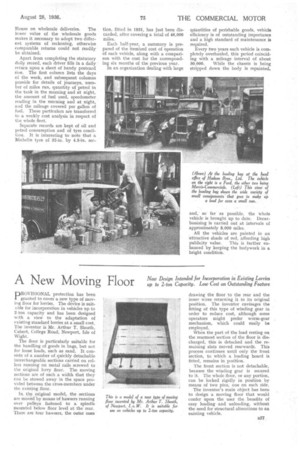Widespread Distribution Service of a Big Grocery Concern
Page 36

Page 37

If you've noticed an error in this article please click here to report it so we can fix it.
ONE of the greatest problems facing the transport executive in the distributive trades is the arrangement of drivers' duty schedules to comply with the hours' regulations. In the case of a high-class concern of grocers and provision merchants, such as Hudson Bros., Ltd., the problem is not, however, so complex, because shops are closed earlier than in the case of businesses of the more "popular " type.
The company has 30 branches, 13 of which are in London. The country depots are at Bexhill-on-Sea, Bournemouth, Canford Cliffs, Brighton, Eastbourne, Epsom, Folkestone, High Barnet, Have, Northwood, Southampton, Southsea, St. Albans, Surbiton, Sutton, Walton-on-Thames and Woking. The largest of these—a most imposing establishment—is at Bournemouth and to it are assigned four vehicles. Altogether, the company's distributive fleet in constant service numbers 31 vans, in addition to which there are some half a dozen spares, whilst the services of haulage contractors are largely employed. The machines in use are of Austin, Ford, Leyland and Morris-Commercial makes, and range in pay-load capacity from 10 cwt. to 6 tons.
So far as the London area is concerned, deliveries are made each morning from head office to the company's branches and customers in the City and West End, the vans leaving Gillingham House, Gillingham Street, London, S.W.1, at about 8.30 a m. In the afternoon, deliveries to the suburbs are effected.
Decentralization.
Although the vehicles allocated to the company's country branches (and in the case of certain London depots) are in the charge of the local managers, transport, as a whole, is controlled from head office by Mr. E. W. Russell, who has been traffic manager since 1919. The local branches make weekly returns to head office of mileages covered by vehicles used by them, details of the value of loads carried. petrol and oil-consumption statistics, etc.
The particulars of value of loads carried are required to ascertain whether the use of the vehicle is economically justifiable. To arrive at a similar decision, careful particulars are kept of the tonnage carried by the vehicles operated from Gillingham House on wholesale deliveries. The lower value of the wholesale goods makes it necessary to adopt two different systems of reckoning, otherwise comparable returns could not readily be obtained.
Apart from completing the statutory daily record, each driver fills in a daily return upon a sheet of handy postcard size. The first column lists the days of the week, and subsequent columns provide for details of journeys, number of miles run, quantity of petrol in the tank in the morning and at night, the amount of fuel used, speedometer reading in the morning and at night, and the mileage covered per gallon of fuel. These particulars are transferred to a weekly cost analysis in respect of the whole fleet.
Separate records are kept of oil and petrol consumption and of tyre condition, It is interesting to note that a Michelin tyre of 32-in. by 4.5-in. sec
tion, fitted in 1931, has just been discarded, after covering a total of 46,000 miles.
Each half-year, a summary is prepared of the itemized cost of operation of each vehicle, along with a comparison with the cost for the corresponding six month s of the previous year.
In an organization dealing with large
quantities of perishable goods, vehicle efficiency is of outstanding importance and a high standard of maintenance is required.
Every two years each vehicle is completely overhauled, this period coinciding with a mileage interval of about 30,000. While the chassis is being stripped down the body is repainted, and, so far as possible, the Whole vehicle is brought up to date. Decarbonizing is carried out at intervals of apprOximately 8,000 miles. • All the vehicles are painted in an attractive shade of red, affording high
publicity value. This is further enhanced by keeping the bodywork in a bright condition.




















































































